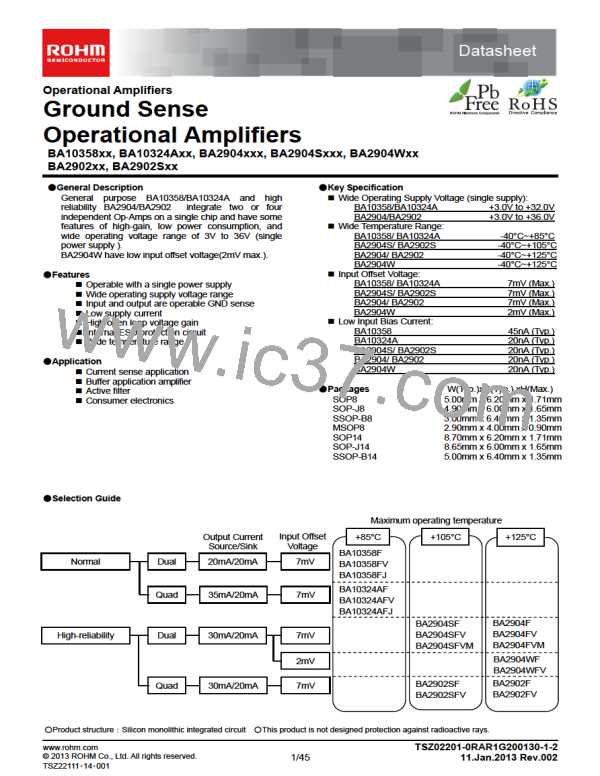BA10358xx, BA10324Axx, BA2904xxx, BA2904Sxxx, BA2904Wxx
BA2902xx, BA2902Sxx
Datasheet
●Power Dissipation
Power dissipation (total loss) indicates the power that can be consumed by IC at Ta=25℃(normal temperature). IC is
heated when it consumed power, and the temperature of IC chip becomes higher than ambient temperature. The
temperature that can be accepted by IC chip depends on circuit configuration, manufacturing process, and consumable
power is limited. Power dissipation is determined by the temperature allowed in IC chip (maximum junction temperature)
and thermal resistance of package (heat dissipation capability). The maximum junction temperature is typically equal to the
maximum value in the storage temperature range. Heat generated by consumed power of IC radiates from the mold resin
or lead
frame of the package. The parameter which indicates this heat dissipation capability (hardness of heat release) is called
thermal resistance, represented by the symbol θja℃/W. The temperature of IC inside the package can be estimated by this
thermal resistance. Figure 102. (a) shows the model of thermal resistance of the package. Thermal resistance θja, ambient
temperature Ta, maximum junction temperature Tjmax, and power dissipation Pd can be calculated by the equation below:
θja = (Tjmax-Ta) / Pd
℃/W
・・・・・ (Ⅰ)
Derating curve in Figure 102. (b) indicates power that can be consumed by IC with reference to ambient temperature.
Power that can be consumed by IC begins to attenuate at certain ambient temperature. This gradient is determined by
thermal resistance θja. Thermal resistance θja depends on chip size, power consumption, package, ambient temperature,
package condition, wind velocity, etc even when the same of package is used.
Thermal reduction curve indicates a reference value measured at a specified condition. Figure 103. (c) to (f) show a
derating curve for an example of BA10358, BA10324A, BA2904S, BA2904, BA2904W, BA2902S, BA2902.
Power dissipation of LSI
LSI
[W]
の消費電力
Pd (max)
θja=(Tjmax-Ta)/Pd ℃/W
P2
θja2 < θja1
θ' ja2
Ambient temperature
Ta [
℃
]
周囲温度
P1
θ ja2
Tj ' (max) Tj (max)
θ' ja1
θ ja1
75
Chip surface temperature
Tj [
℃
]
チップ表面温度
Power dissipation Pd[W]
0
25
50
100
Ta [
125
150
消費電力 P [W]
Ambient temperature
(b) Derating curve
]
℃
周囲温度
(a)Thermal resistance
Figure 102. Thermal resistance and derating
1000
1000
800
600
400
200
0
BA10324AFJ(*31)
800
BA10324AFV(*32)
BA10358F(*28)
600
400
200
0
BA10358FJ(*29)
BA10358FV(*30)
BA10324AF(*33)
0
25
50
75
100
125
0
25
50
75
100
125
AMBIEN T TEMPERATURE [
]
℃
.
℃
AMBIENT TEMPERATURE [
]
.
(c)BA10358
(c)BA10324
1000
800
600
400
200
0
1000
800
600
400
200
0
BA2904F(*34)
BA2904WF(*34)
BA2904SF(*34)
BA2902FV(*37)
BA2902SFV(*37)
BA2904FV(*35)
BA2904WFV(*35)
BA2904SFV(*35)
BA2902F(*38)
BA2904FVM(*36)
BA2904SFVM(*36)
BA2902SF(*38)
0
25
50
75
100
125
150
0
25
50
75
100
125
150
AMBIENT TEMPERATURE [
]
.
℃
℃
]
AMBIENT TEMPERATURE [
.
(e)BA2904
(f)BA2902
(*28)
6.2
(*29)
5.4
(*30)
5.0
(*31)
(*32)
7.0
(*33)
4.5
(*34)
6.2
(*35)
5.0
(*36)
4.7
(*37)
7.0
(*38)
4.5
Unit
8.2
mW/℃
When using the unit above Ta=25℃, subtract the value above per degree ℃.
Permissible dissipation is the value when FR4 glass epoxy board 70mm ×70mm ×1.6mm (cooper foil area below 3%) is mounted.
Figure 103. Derating curve
www.rohm.com
© 2013 ROHM Co., Ltd. All rights reserved.
TSZ22111・15・001
TSZ02201-0RAR1G200130-1-2
11.Jan.2013 Rev.002
39/45

 ROHM [ ROHM ]
ROHM [ ROHM ]